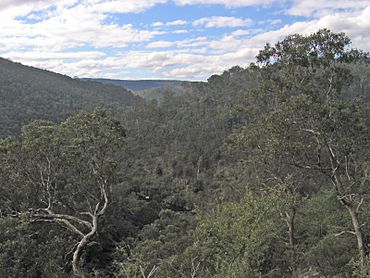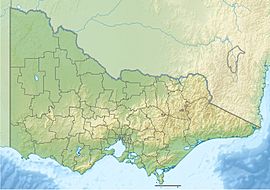Mitchell River National Park (Victoria) facts for kids
Quick facts for kids Mitchell River National ParkVictoria |
|
|---|---|
|
IUCN Category II (National Park)
|
|

The Mitchell River valley looking north from The Bluff Lookout
|
|
| Nearest town or city | Bairnsdale |
| Established | December 1962 |
| Area | 142.5 km2 (55.0 sq mi) |
| Managing authorities | Parks Victoria |
| Website | Mitchell River National Park |
| See also | Protected areas of Victoria |
The Mitchell River National Park is a beautiful national park located in the Gippsland region of Victoria, Australia. This large park covers about 14,250 hectares. That's like 35,212 football fields! It is about 320 kilometers east of Melbourne. You can reach it by taking the Princes Highway. The park is also about 25 kilometers northwest of Bairnsdale. If you want to visit the northern part of the park, you can go through Dargo.
Contents
The Mitchell River
The most important part of the park is the Mitchell River. This river is special because it is the largest unregulated river in Victoria. This means its natural flow has not been changed by dams or other structures. It's a great example of how river environments work naturally.
In 1992, the Mitchell River was named a Heritage River. This shows how important it is for its natural beauty and unique features. It helps us understand how large river systems used to be in south-eastern Australia.
About the Park
The national park is built around the amazing Mitchell River. The river has cut its way through rocks over many years. This has created tall cliffs and deep gorges. The park first started in 1963. It was called Glenaladale National Park back then. An Australian company donated 163 hectares of land to create it.
More land was added to the park in 1986. That's when its name changed to Mitchell River National Park. The park grew even more in 2003. Now, it covers a total area of 14,250 hectares.
Unique Rainforests
Inside some of the gorges, you can find special patches of warm-temperate rainforest. This type of rainforest is usually found in warmer places. It's amazing that it grows here, as it's the southernmost place in the world for this kind of forest!
The steep walls of the gorges help protect these rainforests. They keep the plants safe from the hot, dry summer winds. They also protect them from the bushfires that sometimes happen in the area.
Animals and Plants
The park is home to many different kinds of animals. More than 150 types of birds have been seen here. You can also find 25 different mammal species.
The plants in the park are also very interesting. You might see kanooka trees with papery bark. There are also lilly-pillys, muttonwoods, ferns, mosses, vines, and lianas. In the drier parts of the park, you'll see common Australian trees. These include wattle and eucalypt trees.
Cultural Significance
The Mitchell River area was very important to the Gunai/Kurnai nation. This includes the Brabuwooloong and Brayakuloong people of central Gippsland. One of the most famous places in the park is the Den of Nargun. This place is part of ancient Aboriginal legends.
Europeans also used the area later on. Gold was found here in 1857. People mined for gold along the Mitchell River until the early 1900s. After that, the land was mainly used for timber and farming.
The Den of Nargun Legend
According to the Gunai tribal legends, the Nargun was a scary creature. It was half-human and half-stone. The Nargun lived in a cave called the Den of Nargun. This cave is under a rock overhang, behind a small waterfall. You can find it on Woolshed Creek. This is a small stream that flows into the Mitchell River.
The legend says that the Nargun would take children who went near the rockpool. It was also believed that boomerangs or spears could not hurt the Nargun. They would just bounce back to the person who threw them.
The Den of Nargun was a very special place for the women of the Gunai tribe. They used it for important ceremonies. These ceremonies were for women's initiations and learning. The stories about the Nargun helped keep children away from this sacred area. They also helped keep children closer to their campsites.
Sadly, the cave once had beautiful stalactites hanging from its roof. Over the years, visitors have broken these off as souvenirs. There is another similar site nearby called Deadcock Den. It's also on Woolshed Creek, not far from the Den of Nargun. This place was also very important to the Gunai people, especially the women.
Gallery
-
Panorama of the Mitchell River as it carves a valley through the Mitchell River National Park.
Images for kids







